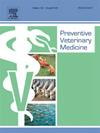Stakeholders’ practices in the pork value chain: Potential risks for Taenia solium and Toxoplasma gondii transmission in Burundi
IF 2.2
2区 农林科学
Q1 VETERINARY SCIENCES
引用次数: 0
Abstract
Pork is one of the most consumed meats in the world, including in Burundi. This study aimed to describe the pork value chain (PVC), stakeholders’ practices, and the implications for the transmission of T. solium and T. gondii in Burundi. A mixed methods approach was used to collect data from stakeholders along the PVC in Bujumbura city, Kayanza, and Ngozi provinces, including literature reviews and food safety regulations. A total of 386 participants took part in the interviews and 63 participated in FGDs and informal conversations. The five types of PVCs were identified. Extensive pig production farms were predominant (81 %) with one to three pigs per pig keeper. Potential risks for porcine cysticercosis and toxoplasmosis in the primary sector included unfit pen conditions, misuse of latrines, open defecation, pigs fed mainly with grasses and leftovers, unsafe water, and human stool for crop fertilization. Home and clandestine slaughters were common for pigs infected with T. solium cysts. Most slaughter slabs did not meet slaughter and carcass transport standards or meat inspection regulations. There was a lack of refrigeration equipment for pork, as well as inadequate pork handling and preparation at retail outlets and homes. Following the HACCP principles, effective ways to mitigate hazards before reaching consumers were identified. This study revealed inadequate practices and their implications for the transmission of T. solium and T. gondii infections in Burundi. Urgent actions targeting the strengthening capacities and multi-sectoral collaboration, raising awareness, and changing practices are essential to control these parasites.
猪肉价值链中利益相关者的做法:布隆迪猪带绦虫和刚地弓形虫传播的潜在风险
猪肉是世界上消费最多的肉类之一,包括在布隆迪。本研究旨在描述猪肉价值链(PVC)、利益相关者的做法以及对布隆迪猪螺旋体和弓形虫传播的影响。采用混合方法向布琼布拉市、卡扬扎和恩戈齐省PVC沿线利益相关者收集数据,包括文献综述和食品安全法规。共有386人参加了访谈,63人参加了专题讨论和非正式谈话。确定了五种类型的pvc。粗放型养猪场占主导地位(81% %),每个养猪户有1至3头猪。初级部门猪囊虫病和弓形虫病的潜在风险包括猪圈条件不适宜、厕所使用不当、露天排便、猪主要以草和剩菜为食、不安全的水以及用于作物施肥的人粪。对感染猪绦虫囊肿的猪进行家庭和秘密屠宰是常见的。大多数屠宰板不符合屠宰和胴体运输标准或肉类检验规定。猪肉缺乏冷藏设备,零售店和家庭的猪肉处理和准备工作也不充分。遵循HACCP原则,确定了在到达消费者之前减轻危害的有效方法。这项研究揭示了布隆迪不适当的做法及其对血吸虫和弓形虫感染传播的影响。以加强能力和多部门合作、提高认识和改变做法为目标的紧急行动对于控制这些寄生虫至关重要。
本文章由计算机程序翻译,如有差异,请以英文原文为准。
求助全文
约1分钟内获得全文
求助全文
来源期刊

Preventive veterinary medicine
农林科学-兽医学
CiteScore
5.60
自引率
7.70%
发文量
184
审稿时长
3 months
期刊介绍:
Preventive Veterinary Medicine is one of the leading international resources for scientific reports on animal health programs and preventive veterinary medicine. The journal follows the guidelines for standardizing and strengthening the reporting of biomedical research which are available from the CONSORT, MOOSE, PRISMA, REFLECT, STARD, and STROBE statements. The journal focuses on:
Epidemiology of health events relevant to domestic and wild animals;
Economic impacts of epidemic and endemic animal and zoonotic diseases;
Latest methods and approaches in veterinary epidemiology;
Disease and infection control or eradication measures;
The "One Health" concept and the relationships between veterinary medicine, human health, animal-production systems, and the environment;
Development of new techniques in surveillance systems and diagnosis;
Evaluation and control of diseases in animal populations.
 求助内容:
求助内容: 应助结果提醒方式:
应助结果提醒方式:


